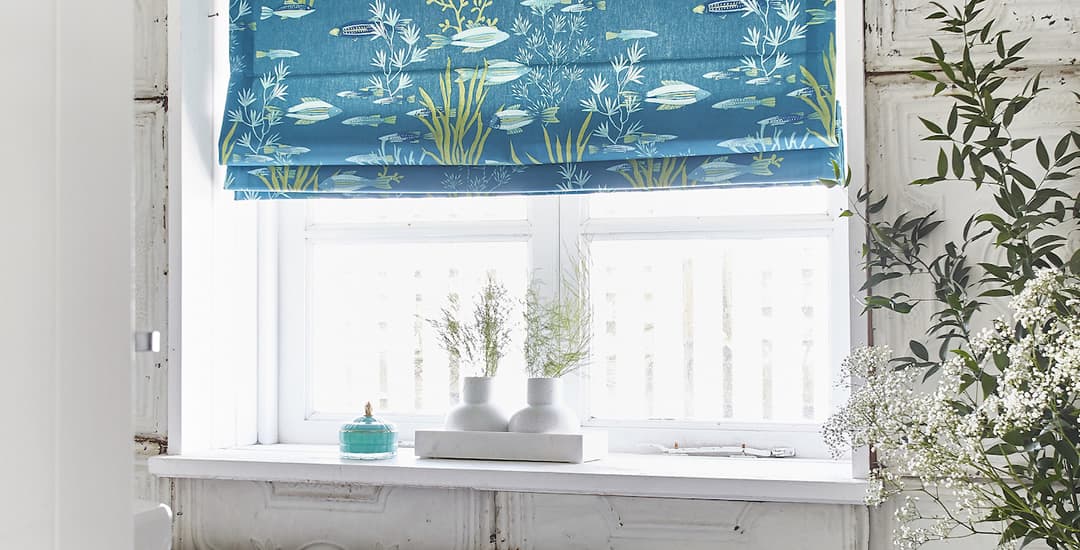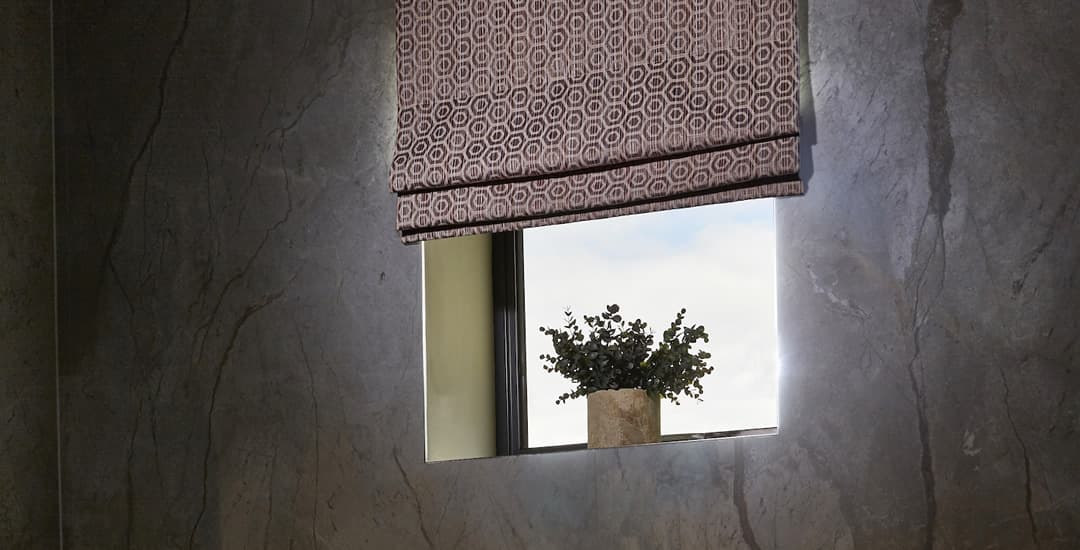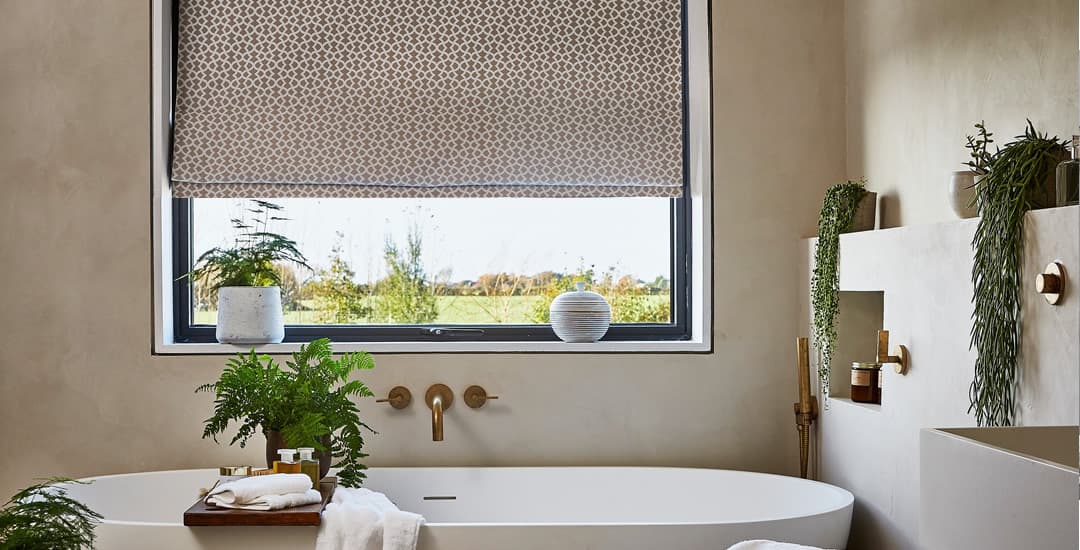
Can you put a Roman blind in a bathroom? In most cases no, or at least, not if you want the blind to act like a blind in good working and cosmetic order for the full extent of its theoretically possible lifespan.
This is essentially because Roman blinds are fabric blinds, and so, aren’t waterproof; and unlike some alternatives like roller blinds and vertical blinds, there is no waterproof option or waterproofing add-on for Roman blinds that could change this.
When it comes to picking blinds for a bathroom, you need to factor in not just the possibility of direct contact with water but also the humidity that will almost certainly develop when the bathroom is in use, both of which are a greater threat to a fabric blind than Sylvester is to Tweety Pie.
This means that it’s not a good idea in the vast majority of cases to have a fabric blind in a bathroom; especially if said fabric blind is made of a costly and delicate fabric, and falls towards the higher end of the price spectrum… Like a Roman blind.
With all of that said, there are some potential exceptions would make a fabric blind like a Roman blind viable for certain bathrooms; so if you do have your heart set on Roman blinds for bathrooms, this is something you might want to look at before you make a final decision.
In this blog post I’ll kick off by explaining why it’s not a good idea to use fabric blinds like Roman blinds in a bathroom (and what might happen if you do) and then list the exceptions that might mean you’ll get away with it; and then share some more information to help you make the right choice for you.
Why can’t you put Roman blinds in a bathroom?
Roman blinds are made of fabrics; perhaps most commonly cotton, and possibly more costly and delicate materials too, like silk or velvet. Generally, natural fibres are preferred for Roman blinds as these are higher-end blinds, which means that achieving a fantastic finish that makes the quality and craftsmanship involved self-evident is integral to the whole nature of Roman blinds, and this is best achieved with premium quality, natural fabrics.
Occasionally Roman blinds are made of polyester, and I’ve given these their own section at the end of this blog post; but for now, take it as script that Roman blinds are made of usually natural and sometimes very expensive fabrics, none of which (including those cheaper polyester options) are waterproof.
Bathrooms come with the dual challenges of the presence of water, and the secondary humidity or moisture in the air that comes from the use of hot water.
Either direct contact with water or absorbing moisture from the air is bad news for a fabric blind, and unless these things only happen once in a blue moon and you take pains to dry the blind off thoroughly each time it happens, it will soon lead to problems.
Fabric blinds that get wet or that harbour moisture may first of all shrink if they’re made of natural fibres; as well as risking watermarking, discolouration, and the colour running in dyed fabrics too.
Also, damp fabrics will tend to attract mould and mildew, which will both ruin the look of the blind and potentially make it smell damp and horrible. In the case of black mould (which is perhaps the most common type of mould that grows in bathrooms) the spores it releases can actually be harmful to your health and cause or exacerbate respiratory problems.
These are the sorts of problems that are apt to develop over time if you use a Roman blind in a bathroom where it will get wet or be exposed to humidity, although the sort of timescale you’d be looking at for any of these issues to arise can be very variable; at worst a few weeks, and at best perhaps a couple of years, assuming that the bathroom is in regular use.
Can you have a fabric blind in a bathroom in any situation?

As a blanket rule with very few exceptions, I strongly advise against putting a Roman blind in a bathroom, but I’m going to go over the possible exceptions that may permit you to get your wish if this is what you want to do.
My bullet points below are all theoretical scenarios, and would really require you to check the blind over regularly (every week or so) to ensure that it’s not getting damp, and drying it off using a hairdryer if it is; this sort of level of maintenance isn’t what most of us are looking for from blinds, and is quite likely to start hacking you off in short order.
Anyway then, can you have a fabric blind in a bathroom in any situation? This may be possible if one or in some cases, two or more of the following scenarios applies. You may be able to have a Roman blind in a bathroom, if:
- The windows are very far from any sources of water and you’re sure the blinds won’t come into direct contact with said water.
- The bathroom is very well ventilated or otherwise doesn’t tend to get very humid or have a lot of moisture lingering in the air. This may be the case in bathrooms with lots of extractor fans and potentially high ceilings; or in bathrooms that you only use very occasionally, if at all!
- The windows of your bathroom don’t get overly condensated when the bathroom is in use, or in general.
- Your bathroom is somewhat borderline in the humidity/atmospheric moisture levels stakes and you’re prepared to consider getting polyester Roman blinds rather than those made of natural material like cotton.
- You’re willing to accept that putting a Roman blind in a bathroom might be something of a sacrificial offering, resulting in the blind shrinking or getting damp to the point that it needs replacing sooner than it otherwise would.
- You redecorate your bathroom every couple of years anyway and would be replacing your blinds along with this; so they won’t really get the chance to suffer unduly from usage in inappropriate conditions.
Can you put a Roman blind in a bathroom as long as it won’t get wet?
If your bathroom is large, with the windows far enough away from any sources of water and splashing then potentially, you might be able to use Roman blinds.
If there is any chance the blinds will get wet this isn’t a good idea, however; and it’s not just direct contact with water you need to be concerned with too, but also the humidity levels in the bathroom.
Even if your Roman blind would never come into direct contact with water, it will suffer all of the same ill effects as if it did if the bathroom gets moist and humid, and/or the windows condensate when the bathroom is in use. This accounts for probably 95% of all bathrooms, and so rules out Romans for most of them.
But can you put a Roman blind in a bathroom where it won’t get wet and there’s sufficient ventilation to prevent it from getting damp? Let’s see…
Can you put a Roman blind in a bathroom that’s well ventilated?
This is another possible/theoretical yes, but it is still something you should think carefully about.
If you do use a Roman blind even in a well-ventilated bathroom where condensation doesn’t seem to linger, it is still wise to check it periodically in case it has somehow got damp and/or begun to develop mould or mildew, or discolouration due to watermarking.
However, by the point that you’ve established that any of these things has occurred and your blind isn’t holding up as well as you hoped for (or you apparently spend far longer in the bath with far hotter water and so, humidity than you’d predicted) it’s pretty much too late to do anything other than look at replacing the blind.
You cannot reverse the damage caused nor stop further damage from occurring when a fabric blind has been damp for a while or repeatedly exposed to atmospheric moisture, short of stopping using the bathroom (and so, generating moisture) entirely.
That’s not to say that Roman blinds don’t work and won’t survive in any bathroom, however; some bathrooms genuinely are well ventilated enough to keep fabric blinds safe. These are usually large, high-ceilinged ones, which may also have multiple extractor fans or users who believe in having lots of windows open all year round.
Can you put a Roman blind in a bathroom if the blind is made of polyester?

Finally, Roman blinds can be made in many different fabrics, with polyester being one of the most common or practical base fabrics (often with trims or accents in other materials) but silk, cotton and other delicate fibres may be used too.
Polyester then? If you’ve got a polyester Roman blind or are willing to consider getting one, does that make any difference? Can you put a Roman blind in a bathroom if it’s made of polyester, and isn’t trimmed in or finished with anything else?
Well. Under the same usage conditions and level of exposure to direct contact with water or atmospheric moisture, a polyester Roman blind will definitely fare better than a cotton or particularly, silk blind; as natural fibres will potentially shrink over time if they gets wet.
A polyester Roman blind won’t shrink, but it will still be prone to all of the other issues any fabric blind will face in bathroom usage conditions, such as starting to grow mould and mildew, and looking and possibly smelly nasty as a result.
I’ve even heard of someone who had a Roman blind in a bathroom that grew its own crop of unpleasant-looking mushrooms in one of the blind’s folds, which was actually fascinating in a “well at least it’s not happening to me” kind of way.
Wondering if this line alone has been enough to swing it against Roman blinds as bathroom blinds for some of you, despite your getting this far…




